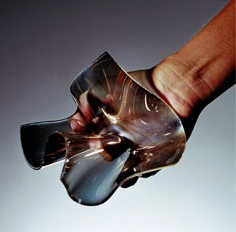Material evolution has a long history – one that goes back almost to the start of human civilization. Material evolution brought about the switch from stone to iron as a superior tool material way back when, and then from iron to steel, and steel to stainless steel. Each advance in technology and human living standards is preceded by a material development: the development of cotton mills, gins and plantations was a driving factor in the Industrial Revolution, because it meant that strong, warm, lightweight clothing was an achievable and aspirational item. Before cotton, people had worn wool, silk and linen, three materials not known for their comfort. At roughly the same time pig iron, which was dense and liable to fractures was replaced by steel, a much more effective material, both for tools and building. This was the birth of the modern era, and it came from materials. The materials we use are synonymous with the age that they usher in; so we had the Stone Age, the Bronze Age, the Iron Age, the Plastics Age, and now the Silicon Age, because the largest part of the consumer market is taken up with things that run by, or through, silicon chips.
Silicon might seem like the end of the story: it’s relatively abundant and cheap to work with (take a handful of sand, heat it up, and you have the basics of a chip), but silicon has some downsides. Moore’s Law states that computers will become half the size, or have twice the computing power, at the end of a two-year cycle. While this isn’t an inviolate law, it does place certain pressures on manufacturers to devise new ways to lay chips. Transistors can be bulky and they throw off plenty of heat, and that can lead to decreased resistance and eventual chip failure. Silicon, nature’s wonder material, is already starting to show its age. In an era where smartphones are judged by their thickness in milimeters, not centimeters, silicon is becoming a bulky liability.
The next age in materials beckons, but nobody’s quite sure what to call it. Here are some materials I think are going to come to prominence in the near future:
Graphene
The new era might as well be called “the carbon age”, because it’s only now we’re discovering that Carbon, an abundant element, has practical uses beyond what we imagined.
Carbon is the slut of the periodic table: its high reactivity and inclination to make strong bonds mean that it’s found in just about everything. Every component of your cells uses carbon to some degree (carbohydrates, proteins, fats and DNA all utilise carbon at the molecular level) and it bonds to nearly every element, given the right circumstance. most of all Carbon wants to bond to itself, and it does so with impalcable strength: think diamonds. Graphene is a fairly straight-forward step from that: imagine a diamond an atom thick. Graphene is just carbon atoms arranged in a hexagonal arrangement, on a scale of thickness below human comprehension.
The best thing about Graphene is it conducts electricity with very low resistance and high electron mobility, making it ideal for building circuits on top of super-thin layers of silicon. This doesn’t sound like much, but Graphene is also extremely durable, making it ideal for building small-scale electronics. The arresting image is of a silicon chip as complex as those we have now, but finer than a human hair.
Graphene is difficult to produce in large amounts, but recent developments mean that it will soon be in production. Two years ago IBM announced it had made the first integrated circuit out of graphene, meaning that large-scale production isn’t too far away. The implications are immense: microscopic electronics and solar cells on every surface, providing immense amounts of energy. Silicene, the same sort of material but made of Silicon, is speculated to be useful in hydrogen storage, bringing cold fusion that much closer.
Carbon Nanotubes
More Carbon. Carbon’s kind of boring to write about but the key message to take from it is this: stuff we thought was pretty basic turns out to be massively complicated. Way back, we thought there were only a couple of forms of Carbon: diamond, graphite and Carbon dioxide. Carbon nanotubes are similar in many ways to graphene, but subtly different: in this case arranged into neat little tubes, as the name suggests. Big deal, right? Well actually, yeah. Remember that scene in The Amazing Spiderman when Andrew Garfield fools around with webbing? I’m pretty sure that was carbon nanotubes, which would make sense: they have incredibly high tensile strength with a very low cross-section, meaning that they’re as strong as steel with the thickness of silk. They can withstand greater pressure than a diamond can (it’s something to do with the ring shape) and weigh a miniscule fraction compared to any other tensile material.
It’s all a bit sci-fi and still very much an emerging technology, but the belief is that megastructures (that’s really big buildings and stuff) will one day be built of carbon nanofibre. There’s even the suggestion that the material would work for a space elevator.
To summarise: Do you want to web-swing to work?
Memory Metals
Imagine a sheet of aluminium foil that flattens itself out, ready for re-use, or car bumper that smooths its own dents, or glasses you can’t break by sitting on them. Memory metals return to their forged shape when heated, in effect making them kind of indestructible. Metal fatigue is serious business in certain fields, such as in piping, aircraft manufacturing and automobile design, and the idea of a metal that can be subjected to immense stress is pretty exciting. Memory Metals have two different states: either they only remember the shape they were in when forged, or they have two different shapes: a hot and a cold one. The way they do this is due to the crystallisation process (which I’m a bit too stupid to understand), but the consumer implications are pretty far-reaching: consumer electronics that contour to the environment they’re placed in, or unbreakable bra underwiring, or megastructural engineering, and maybe a thousand other applications.
So why aren’t they widespread? A couple of reasons. They’re quite difficult to produce, for one. The other is more insidious: if you’re a manufacturer, you want to make a good product, yeah? But you don’t want to make it too good, or people will never buy another one. If Ford made a car that lasted a hundred years, there’d be no more Fords.
I have a friend doing a PhD on Metamaterials. Now, I don’t class myself as stupid, but understanding Metamaterials and describing Metamaterials to you, my lovely reader, is beyond me. It was beyond her to get me to understand until she hit on the only description left: “Would you like to own an invisibility cloak?” she said. “Hell yeah!” I said. “Then stop bothering me at work,” she said, and hung up.
So there you have it. I don’t know what they are, but from reading the wikipedia page (or rather skimming it while watching Dexter) I can tell you this: 1) Metamaterials are complicated as shit, and 2) They’re totally crazy. Basically they’re materials made to have specific properties that you don’t find in nature, such as being able to absorb all light, or redirect it, or something. The next generation of stealth jets will have a Metamaterial coating that allows them to absorb radar. Eventually they might appear sandwiched in between windows, so that you can turn the transparency of a window up or down depending on preference. And invisibility cloaks.
Conclusion? I’m not as smart as I think I am.
Bamboo
I’m cheating: Bamboo isn’t a new material (but finally something I can fully understand). Bamboo is one of the most versatile materials available to us. I don’t know why we still use wood. Seriously. Wood is unbelievably time-consuming and expensive to grow, and deforestation is a serious threat to a number of ecosystems. Bamboo, on the other hand, can grow a meter in 24 hours. You can eat it. You can make clothes out of it. You can make paper out of it. You can use it in construction: it makes great scaffolding. You can make cooking utensils out of it. It even has some uses in medicine. You know when stoners always go on about how awesome hemp is and how we should grow it ourselves yadda yadda yadda? Bamboo has them all beat, and the only reason they don’t care is that they can’t smoke it. In short, stoners are idiots.
But Bamboo is something else, and I believe the only reason it doesn’t have widespread use in the West is that it isn’t a traditional building material and hasn’t caught on. This is a shame, and probably something that needs fixing: with Bamboo we could solve textile shortages and reduce deforestation, improve construction efficiency and give people something else to eat. Will we? I don’t know.







That was really interesting. The possibilities are fantastic. Etty-bitty solar cells – unlimited clean energy – would literally change the world. I hope I’m alive to see it.
Well unless you’re super old, like eighty, I think you will. Consumer solar panels are rapidly gaining a foothold. My parents had some installed o their house a few years back. In Germany they’re replacing conventional nuclear power as a percentage of the energy economy. It’s happening largely due to new materials like graphene and semiconductors.
I hope you are right. I so hope you are right. It will truly change the world.